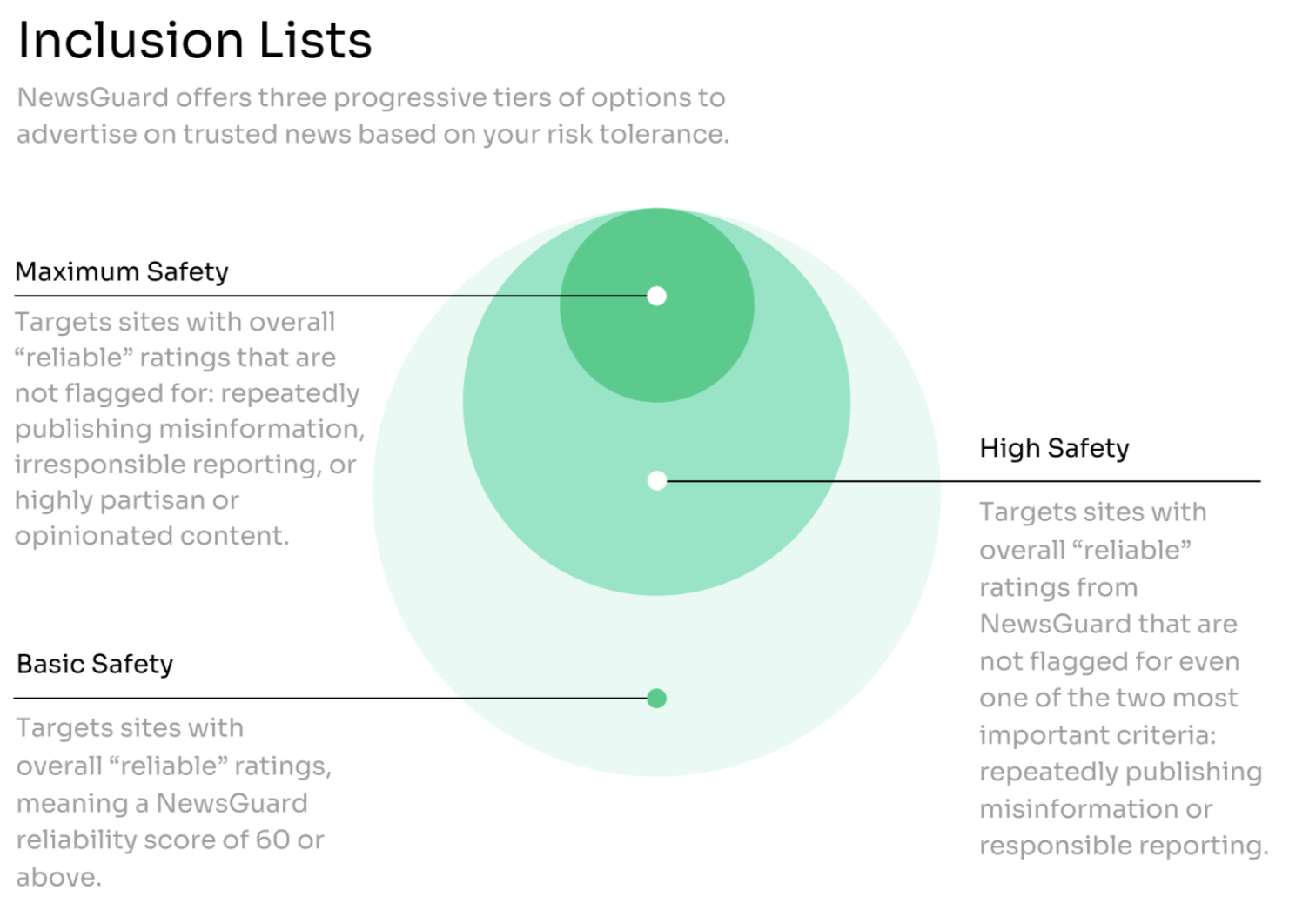12/07/2022
NewsGuard Launches New Brand Safety Tiers, Enabling Greater Control for Advertisers to Support Credible News and Avoid Misinformation
New inclusion levels go beyond Red and Green ratings, giving advertisers new choices with simple, clear options
(December 7, 2022 – New York City) NewsGuard, the leading provider of news credibility data for advertisers, agencies, and ad exchanges, today announced that it is expanding its brand safety service to make it easier for brands to advertise responsibly on news while avoiding risk.
NewsGuard’s brand safety service, BrandGuard, is derived from its Reliability Ratings of news and information websites. The ratings are compiled by trained journalists based on nine apolitical journalistic criteria—such as whether a site transparently corrects factual errors, distinguishes news from opinion, or uses deceptive headlines—and cover all of the news and information sites that account for 95% of online engagement with news. Each website receives a 0-100 score, a rating of Green or Red, indicating its overall credibility, and a score on each of the nine criteria.
The upgrade includes new brand safety tiers that go beyond the binary rating levels to enable each brand to tailor its approach to advertising on news to account for its brand values and risk tolerance level for campaigns. These tools are primarily used with programmatic advertising to reduce the brand risk from marketers not knowing where their ads run, though can also be used with directly purchased campaigns. Those options are:

“We’ve always offered brands significant flexibility in how they apply our ratings, with point scores and ratings on nine distinct criteria, along with more than 40 metadata points giving advertisers more information about each site,” explained NewsGuard General Manager Matt Skibinski. “As we’ve seen brands experiment with different ways to apply our criteria and metadata for ad targeting and exclusion lists, we’ve now made it easier for brands to choose different approaches, including the most popular use cases that brands apply for their campaigns.”
“These new segments take everything we’ve learned from that process and make it easy for any brand to use our data flexibly and in line with their specific needs—with simple, easy segments to choose from for inclusion and exclusion list use cases,” he added.
For example, the new tiers enable a brand that wants to prioritize safety to exclude not only misinformation and conspiracy websites, but also sites that may often be credible but that have had significant exceptions to their adherence to journalistic standards, such as mixing news and opinion or publishing significant factual errors on key topics. NewsGuard’s “Maximum Safety” inclusion or exclusion segments support this use case by filtering out any website that fails even one of the major credibility criteria NewsGuard assesses, is noted as strongly opinionated or partisan, or has other credibility flags in NewsGuard’s ratings.
Conversely, a brand or ad tech provider that wants to prioritize reach while still avoiding supporting clearly harmful misinformation may choose to focus on only the “worst of the worst” by choosing NewsGuard’s “Basic Safety” segment, which includes sites that regularly traffic in egregiously false claims, such as sites promoting the QAnon conspiracy theory or spreading Russian disinformation about the war in Ukraine.
Case studies have found that applying this kind of precision to ad buys can result in significant campaign performance benefits for advertisers. A case study based on NewsGuard data found that targeting a custom list of highly credible news sites—with high trust scores, no major criteria failures, and no flags for partisanship or other strongly opinionated content—resulted in a 143% increase in click-through rates with 9% lower CPMs. NewsGuard’s new “Maximum Safety” is similar to the custom list used in this case study—making it easy for brands to buy ads on the same kind of high quality, high-performing news inventory.
“This addition to our BrandGuard service is a reflection of the increasingly detailed and precise nature of our ratings and Nutrition Labels,” said Sarah Brandt, NewsGuard’s Executive Vice President, Partnerships. “We’ve now made it easier for brands to take advantage of that nuance by adapting our ratings to their specific needs and risk tolerance levels—while still keeping it simple and easy to activate our data.”
“Advertising responsibly on news is now easier than ever,” Brandt added.
To learn more about activating NewsGuard’s protections for advertisers, click here or contact [email protected].
About NewsGuard
Launched in March 2018 by media entrepreneur and award-winning journalist Steven Brill and former Wall Street Journal publisher Gordon Crovitz, NewsGuard provides credibility ratings and detailed “Nutrition Labels” for thousands of news and information websites. NewsGuard rates all the news and information websites that account for 95% of online engagement across the U.S., U.K., Canada, Germany, France, and Italy. In August 2022, NewsGuard also launched in Austria. NewsGuard products include NewsGuard, BrandGuard, which helps marketers concerned about their brand safety, and the Misinformation Fingerprints catalog of top hoaxes.
In 2022, NewsGuard began rating television news and information programs and networks using criteria similar to those used to score websites but adapted for the video medium. NewsGuard’s TV ratings are the first to go beyond its initial ratings of websites. Ratings for news and information podcasts will also be available for licensing in 2023.
NewsGuard’s ratings are conducted by trained journalists using apolitical criteria of journalistic practice.
NewsGuard’s ratings and Nutrition Labels are licensed by browsers, news aggregators, education companies, and social media and search platforms to make NewsGuard’s information about news websites available to their users. Consumers can also access NewsGuard’s website ratings by purchasing a subscription to NewsGuard, which costs $4.95/month, €4.95/month or £4.95/month, and includes access to NewsGuard’s browser extension and mobile apps. Hundreds of public libraries globally receive free access to use NewsGuard’s browser extension on their public-access computers to give their patrons more context for the news they encounter online. For more information, including to download the browser extension and review the ratings process, visit newsguardtech.com.